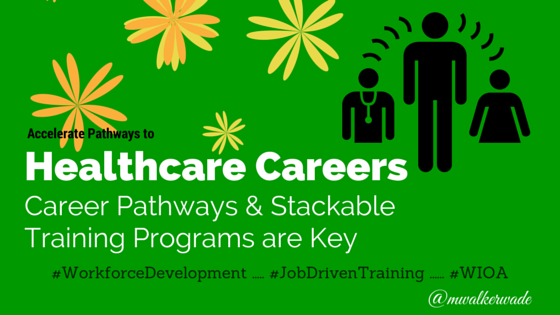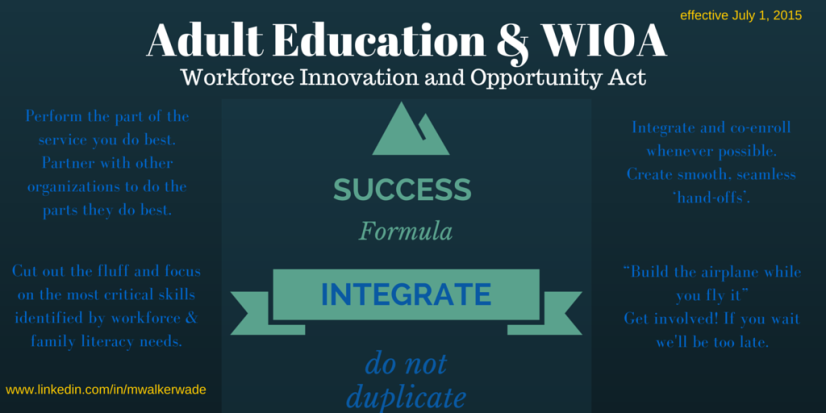Archive
When is language the barrier to building literacy skills?
This very well-written piece gets right to the heart of the objectives we should emphasize when working with English language deficient adults.

Increasingly we hear from trainers that there are more learners for whom English is a second, or third, or … language in the course they deliver. This brings additional challenges to assist learners who may be unfamiliar with the workplace context and language. Language is the link or key to being able to grasp concepts, interpret texts, and communicate.
It’s not surprising that more trainers speak about the multiple languages spoken by learners in class. The Australian Bureau of Statistics (ABS) reveals:
- in 2016, for approximately 40% of the Australian population English is not their primary or first language.
- in 2016, over 400 languages were spoken in Australia – more than a 100% increase since 2006.
- the percentage of the population that speak only English is declining.
Furthermore, RTO delivery has expanded to include training within, or for countries other than Australia, so more trainers are involved with workplace training and…
View original post 930 more words
Bringing Manufacturing JOBS Back to the US
Have you heard all the whoopla about bringing manufacturing jobs back to the US? The real economist say it can’t happen; and I agree with them. Idealistically it sounds great, but fiscally I don’t see how it could ever work (especially in California). This California EDD Labor Market Report supports my thinking. It says:
“manufacturing sector is expected to lose 40,100 jobs through the projection period. This sector has a long history of declining employment due to increases in automation and outsourcing…”
Manufacturing may surge in the US; but manufacturing JOBS will not.
Have you seen what became of the old NUMMI plant which once was the biggest employer in Alameda county? It’s now the TESLA plant. It still manufactures automobiles, but it employs minimal human resources. TESLA employs robotics to do the grunt work of manufacturing vehicles. If your dream job involves building cars, you may want to spend a little more time gaining higher-level math, problem-solving, and computer skills (like coding, computer aided drafting and so forth). Take a look at this video:
Compare what you just saw at TESLA to this short overview of the old NUMMI plant. There was quite a bit of automation then; but you’ll also see a lot of human talent involved in getting the job done.
This major shift in automobile assembly and the unemployment of more than 5000 people only took 20 years to happen. I remember when the NUMMI plant opened, and I was on the front line helping calm the most frantic dislocated workers through the emotional experience of job loss, financial calamity, and workforce skills deficiency. If your dream job involves building cars, you may want to spend a little more time gaining higher-level math, problem-solving, and computer skills (like coding, computer aided drafting and so forth).
Manufacturing isn’t the only industry that will see many of it’s jobs replaced by robotics. Anywhere it can happen, it will happen. Consider the self-driving vehicles being tested right now. The long-term plan, as I understand it, is for the transportation industry to replace truck drivers with self-driving big rigs.
The point of my writing this article is this: Right now workforce systems will promote manufacturing careers, and that’s good for now; but for those who choose manufacturing as a career pathway, always remember the future plan is for robotics to replace humans. Use this knowledge to your advantage and as a constant motivation not to get comfortable doing the same thing over and over. If you can do it over and over, so can a robot. Diversify your skill-set and invest time in learning innovative, higher-level thinking. See yourself several steps ahead of where the industry is today.
No matter what industry you currently work in, take out a little time to see how things are changing in the manufacturing industry.
National Manufacturing Day is October 2, 2015. So far there are over 600 events nationwide planned for this day. Go to www.mfgday.com to find an event near you.
Creating Accelerated Career Pathways into Healthcare
 According to Manpower’s 2015 Talent Shortage Survey (#TalentShortage), nursing occupations is #7 on a list of 10 industries. For survey purposes, nurses includes:
According to Manpower’s 2015 Talent Shortage Survey (#TalentShortage), nursing occupations is #7 on a list of 10 industries. For survey purposes, nurses includes:
Non-degree: CMAs, PCAs, CNAs, HHAs, LPNs, and LVNs
Degreed: RNs
Advanced degree: APNs, NPs, PAs, CLNs, CNSs, CNMs, CRNAs
According to Stephanie Neuvirth, chief human resources and diversity officer at City of Hope in Duarte, CA:
“Jobs in accounting, finance, IT and administration are plentiful in health care. Although these jobs provide the infrastructure for the health care industry, parents, guidance counselors and students don’t realize they exist.”
Career fields such as healthcare, especially where patient contact is key, are challenging to fill because success depends on having the right combination of soft skills, technical skills, and physical ability. Certain roles in health care also needs individuals who are able to relate to the cultural and spiritual norms of the patient. Healthcare providers in Duarte, CA understand this challenge all too well, as 71% of their patients are Hispanic.
“Only 6 percent of the physicians and 8 percent of the nurses in the U.S. are Hispanic”
When I look across the landscape of career education, I see many schools providing training in allied healthcare, yet employers still struggle to get the type of employee they really need. It’s clear that the typical training program is not quite hitting the mark. In some cases the problem is the curriculum, in other cases the problem is access to internships, but in some cases (and I hate to say this) it’s the student. I’ve had first-hand experience on numerous occasions where a student wanted to join my healthcare training program because “there’s a lot of jobs in healthcare”. As a program manager, if your primary concern was getting enough students enrolled into the course to meet your revenue target, it may be easy to fill your class with students who can do the technical skills of medical care, but who lack the genuine compassion for patient care. These type of students will ultimately be fairly unemployable in the healthcare industry. As workforce development planners and education & training providers I believe this is something that deserves our consideration.
There are three programs making an impact on suring-up our need for qualified and quality health care talent I’d like to share with you:
CareerSTAT is “an initiative to document and endorse the business case for investments in frontline hospital workers and to establish an employer-led advocacy council to promote investments that yield strong skill development and career outcomes for low-wage, frontline hospital workers”. Nearly 100 health care organizations partner with CareerSTAT including Kaiser Permanente and Banner Health. Some of their activities include:
- An employer-led national collaboration of health care leaders
- A clearinghouse for best practices in health care and shared information in training development
- A focus on early college and career pathway programs and provides low-income and minority students with access to in-demand health care careers
- Work towards initiatives that would get Hispanic youth engaged in health care careers
TEACH Project (Train, Educate, and Accelerate Careers in Healthcare)- seeks to create skilled workers in health IT. This project works with high-school students to provide education, training and job shadowing opportunities, integrated with their current school studies. Students concurrently receive high-school credit, community college credit, and on the job experience that accelerates their entrance into a job in the medical field.
Homebridge, Inc in San Mateo, CA – One of the most advanced employer-based, entry-level training programs into the medical field. The Homebridge training program provides adult-centered, competency- based training curriculum, designed to be accessible to students with a minimum of 6th grade proficiency. The training highlights the value of hands-on learning and includes a simulation apartment where caregivers can practice with beds, wheelchairs, and bathroom facilities. Success in the classroom is supported in the field by peer mentors who provide on- the-job training and a work-life coach who addresses barriers to job retention. Because of their strong emphasis on training & development, Homebridge’s 37% turnover rate for frontline caregivers is 31% lower than the 54% national average.
As workforce developers and education & training providers move forward with WIOA (Workforce Innovation & Opportunity Act) implementation activities, I believe programs like these give great models to emulate, but more so, some good starting points for finding the right kind of partnerships. Remember, partnerships and “stackablity” are key components to a successful WIOA funded program.
This article is based on my own research, therefore I have no endorsement of any kind from these three programs. If you’d like to read more about them you’ll find articles at these two links.
CareerSTAT & TEACH – http://tinyurl.com/p8vjymn
Homebridge, Inc: http://tinyurl.com/o88rjsf
Adult Literacy Education Providers Prep for WIOA’s Integrated Education and Training pt 2
THE WIA-TO-WIOA TRANSITION BEGINS JULY 1, 2015
THE UPCOMING ACADEMIC YEAR IS A YEAR OF CHANGE
In 2012 the U.S. Department of Education Office of Vocational and Adult Education produced a 30-page document titled: Promoting College and Career Readiness: Bridge Programs for Low-Skill Adults. If you read through it, you will see very sharp resemblances of what we as Education & Training professionals should be focusing on to gear up for WIOA changes on our campuses and in our classrooms. Some of the terms in the report vary from the terms in the WIOA proposal, but the meanings are the same.
♦♦♦ I will highlight some of the report’s content below ♦♦♦
Create bridge programs (“Pathways”) to help adult students identify career and education goals and develop the skills, content knowledge, and learning strategies needed to enter and succeed in postsecondary education and employment.
Combine (“Integrate”) basic skill instruction in reading, math, writing, and English language, including preparation for the GED test, employment skills, and college success strategies. Some bridge programs also offer college credit and certificates (“Nationally recognized credentials”), which may be the first step toward a college degree.
Use state and local labor market information develop bridge programs focused on occupations or industry sectors with a high demand for employees. ♦ Note: Your local Workforce Investment Board will need to be very involved in your education and training program planning, per WIOA.
For examples of what your education and training programs should emulate, consider these:
- Washington’s I-BEST approach: an integrated ABE (and now ELA) and CTE instructional planning process and co-teaching.
- Oregon Pathways for Adult Basic Skills Transition to Education and Work Initiative (OPABS) provided the impetus for the state’s Adult Basic Skills (ABS) system to incorporate career pathways and assist in transitioning learners into further education and employment, including formal connections to postsecondary education and OneStop Career Centers.
- (Alabama Community College has also gained recognition for being fairly “WIOA Ready’ and therefore also serve as a great example for planning and implementation.)
Finally…
Look to form partnerships with organizations such as these:
Jobs for the Future (JFF) Breaking Through and ABE to Credentials initiatives
The Joyce Foundation Shifting Gears initiative
The Nellie Mae Education Foundation New England ABE-to-College Transition project
The time to get involved and to start your transitional planning is now.
Sources:
http://www2.ed.gov/about/offices/list/ovae/pi/cclo/brief-1-bridge-programs.pdf
WIOA!!! What’s Going to Happen to Low Literacy Adults (Part 2)
Many adult education practitioners share the concern that while WIOA legislation ‘says’ Family Literacy is an eligible activity, the law is so job-focused that it seems to leave no room for parents who do not work outside of the home, or for full-time caregivers, nor for retirees/senior citizens who do not plan on returning to work. This is a fully-loaded question and may be the reason why so many adult education professionals are not ready to tackle the changes WIOA may bring. It’s not yet clear where this demographic of learners will fall in the spectrum, nor how education providers will account for serving this group of participants under WIOA. It is believed that changes to core ESL programs will happen later on in the transitional phase-in of WIOA. Some have asked about the possibility of Federal WIOA funds (vs. State funds) be used to serve Family Literacy needs. For now, the answer to this question has not been clarified. The good news is…this concern has been heard! Take a look the National Skills Coalitions May 18th webinar. It’s one of the best I’ve seen to address concerns most relevant to Title II / AEFLA thus far. https://youtu.be/I1GdL6f6Tx0
Do You Believe in Upskilling?
 “Upskilling” involves work-based training and coaching that results in the growth of an organization’s talent pool by promoting from within. Upskilling, and the visible awareness of opportunities for promotion, reduces employee turnover and increases job-satisfaction. As a strong proponent of Career Management, I encourage career-minded individuals to continually look for opportunities for skill and developmental growth. If your employer provides access to training workshops and courses, take advantage of it. If they provide tuition assistance, grab it! Always keep your eye on 2 or 3 other positions in your company you’d be interested in doing. Depending on the level of responsibility of your current position, your next career move (whether a lateral move or a promotion) should happen every 2 to 5 years. When I was in my early 20s I left my position as an Account Clerk at a small health clinic to take a position as a Messenger working for Chevron Corporation in downtown San Francisco. I literally “pounded the pavement” every day. After a few months, I was given the opportunity to work on a special assignment in Messenger Dispatch. When that assignment ended, I went back to pounding the pavement. Before the week ended, the corporate mailroom requested for me to fill-in for someone who was out ill. I ended up working in the corporate mailroom for the next 6 months. As soon as I reached my required time-in-service, I began applying for other positions. Within no time I went from the mailroom to the 19th floor of one of Chevron’s executive offices. I became the Receptionist of the International Oil Division. While working in this position I noticed two times of day when foot traffic slowed and the executives rarely needed my assistance. I used those times to self-teach myself Lotus 123 and to study my Accounting terms, t-accounts and formulas. Once again when I reached my time-in-service I applied to work in Accounts Payable. I nailed that promotion on the first attempt! From there I promoted multiple times within Chevron’s Financial Services department. At that time Chevron had a robust Training & Development department complete with a computer-based (self-paced) training lab as-well-as regularly scheduled trainer-led workshops. I took advantage of both. Chevron had a tuition assistance program that reimbursed employees 75% of the cost for college tuition and books. I did that too! My career path at Chevron occurred over a 9.5 year-span. I never stopped ‘upskilling’ and I never stopped promoting to higher positions. It only ended when Chevron offered early retirement packages as a part of their downsizing efforts. At the age of 30 I took the package so I could finish college and start a new career in the education industry. Part of the package included one more year of college fees reimbursements. Of course I took advantage of that too. Upskilling works! The WIOA (Workforce Innovation & Opportunity Act) legislation aims to encourage more emphasis on upskilling. I hope to hear many stories of organizations and individuals seizing the opportunity WIOA funding creates. I encourage you not to be so consumed with your current work that you neglect to fuel your future. If your current employer creates barriers (instead of pathways) to your professional development it’s time to look for something new. As I always say…
“Upskilling” involves work-based training and coaching that results in the growth of an organization’s talent pool by promoting from within. Upskilling, and the visible awareness of opportunities for promotion, reduces employee turnover and increases job-satisfaction. As a strong proponent of Career Management, I encourage career-minded individuals to continually look for opportunities for skill and developmental growth. If your employer provides access to training workshops and courses, take advantage of it. If they provide tuition assistance, grab it! Always keep your eye on 2 or 3 other positions in your company you’d be interested in doing. Depending on the level of responsibility of your current position, your next career move (whether a lateral move or a promotion) should happen every 2 to 5 years. When I was in my early 20s I left my position as an Account Clerk at a small health clinic to take a position as a Messenger working for Chevron Corporation in downtown San Francisco. I literally “pounded the pavement” every day. After a few months, I was given the opportunity to work on a special assignment in Messenger Dispatch. When that assignment ended, I went back to pounding the pavement. Before the week ended, the corporate mailroom requested for me to fill-in for someone who was out ill. I ended up working in the corporate mailroom for the next 6 months. As soon as I reached my required time-in-service, I began applying for other positions. Within no time I went from the mailroom to the 19th floor of one of Chevron’s executive offices. I became the Receptionist of the International Oil Division. While working in this position I noticed two times of day when foot traffic slowed and the executives rarely needed my assistance. I used those times to self-teach myself Lotus 123 and to study my Accounting terms, t-accounts and formulas. Once again when I reached my time-in-service I applied to work in Accounts Payable. I nailed that promotion on the first attempt! From there I promoted multiple times within Chevron’s Financial Services department. At that time Chevron had a robust Training & Development department complete with a computer-based (self-paced) training lab as-well-as regularly scheduled trainer-led workshops. I took advantage of both. Chevron had a tuition assistance program that reimbursed employees 75% of the cost for college tuition and books. I did that too! My career path at Chevron occurred over a 9.5 year-span. I never stopped ‘upskilling’ and I never stopped promoting to higher positions. It only ended when Chevron offered early retirement packages as a part of their downsizing efforts. At the age of 30 I took the package so I could finish college and start a new career in the education industry. Part of the package included one more year of college fees reimbursements. Of course I took advantage of that too. Upskilling works! The WIOA (Workforce Innovation & Opportunity Act) legislation aims to encourage more emphasis on upskilling. I hope to hear many stories of organizations and individuals seizing the opportunity WIOA funding creates. I encourage you not to be so consumed with your current work that you neglect to fuel your future. If your current employer creates barriers (instead of pathways) to your professional development it’s time to look for something new. As I always say…
“It’s YOUR career – you take care of it!”
Vice President Joe Biden speaks very well about upskilling. Listen here.
What it takes to be a great leader: A recommended reading list
From the looks of things we have lots of reading to do! Reading great texts like ones mentioned In this article is the fastest, least expensive way you can ever go about getting a strategic thought-leader to mentor you. Do you have an innovative idea? Do you play a leadership role in an organization? Are you in the process of stepping up your professional “game”? Well… choose a title and start here! Enjoy.
What Did That Hiring Manager Say? Take an Inside Look
 We’d all love to believe when our résumé and cover letter hits hiring manager’s hands rays of blissful light springs from it, and skittles candy rains down from the sky and fills the room. Right? Well, I’m sorry. I’m here to help, so cannot leave you living in fairyland. Hiring managers probably roll their eyes at more résumés than you can imagine. I’ve noted a few of their comments below. It’s up to you to take an honest look at yourself (meaning your résumé and cover letter approach) and take some corrective action. Here we go…
We’d all love to believe when our résumé and cover letter hits hiring manager’s hands rays of blissful light springs from it, and skittles candy rains down from the sky and fills the room. Right? Well, I’m sorry. I’m here to help, so cannot leave you living in fairyland. Hiring managers probably roll their eyes at more résumés than you can imagine. I’ve noted a few of their comments below. It’s up to you to take an honest look at yourself (meaning your résumé and cover letter approach) and take some corrective action. Here we go…
“Every time a job seeker uses a meaningless descriptive word on their #resume like energetic, another hiring manager becomes just a little more exhausted.” (posted by B. S. on LinkedIn)
- What to do: eliminate the fluff!
“If I have to spend more than 30 seconds finding out what you have accomplished, forget it … Likely, I will ignore the whole thing…”
- What to do: Again, eliminate the fluff and target the resume to the job
“Of the probably close to 1,000 I’ve received, I’ve read less than a hundred submitted cover letters from start to finish. Why? Most people do not take the time to make the letter worth reading.” (poster: Jenny Yerrkin Martin of Careerealism)
- What to do: Read and do the suggestions made in the article: Score! 4 Secrets To Winning Cover Letters by the author, Jenny Yerrkin Martin
“If you’ve been unemployed for a long stretch of time, it makes me wonder what’s wrong with you…” (poster unknown)
- What to do: Stay enrolled in some type of job training/college course AND get busy volunteering at a reputable organization. List both on your resume.
“Applying online is a losing game… We build our application process to weed out candidates…” (poster unknown)
- What to do: Focus more on networking (both in-person and virtually) to get your foot in the door
THAT’S ALL FOR NOW; BUT THERE’S MORE TO COME. CHECK BACK SOON!
Read more here:
Adult Literacy Education Providers Prep for WIOA’s Integrated Education and Training pt 1
 In her article “What you need to know: Workforce Innovation and Opportunity Act (WIOA)” Melinda Mack, Executive Director, New York Association of Training & Employment Professionals says:
In her article “What you need to know: Workforce Innovation and Opportunity Act (WIOA)” Melinda Mack, Executive Director, New York Association of Training & Employment Professionals says:
WIOA’s Intention for Literacy is to “deepen connection between Title I and Title II, through nimble career pathways and vocationally focused literacy (most common example is the I-Best model out of Washington State)‘; including serving low-basic skilled”
These career pathways must be in high-skill, high-wage job industries. Adult Education providers should already be looking for the best ways to fulfill this requirement. The high-skill/high-wage jobs may vary from one area to the next; but, the most typical industries will be healthcare, Computer Science/ Computer Network Technology, Accounting, and Manufacturing Technology. According to ManPower Group, The 10 Hardest Jobs To Fill In 2014 are:
- Skilled Trade Workers
- Restaurant and Hotel Staff
- Sales Representatives
- Teachers
- Drivers
- Accounting and Finance Staff
- Laborers
- IT Staff
- Engineers
- Nurses (see infographic: http://www.manpowergroup.us/campaigns/talent-shortage-2014/assets/pdf/MPG_US_TalentShortagVertInfogrphcFINAL.pdf)
I’m pretty sure career pathways in these industries would satisfy WIOA’s intentions for integrated, job-driven training. Adult education providers should check with your local Workforce Investment Board (WIB) for education and training needs for your region. The WIB produces reports showing which industries in your area are growing, shrinking, and are expected to remain flat. WIOA will also require education providers and local WIBs to work more closely together; so, this information should be pretty easy to obtain. For literacy-level programs, we’ll just need to get students moving along the pathway towards particular industry and help prepare them for entry-level work in fields with great job growth potential. We’ll do this by providing “Integrated Education and Training” – the combining adult education and literacy activities concurrently and contextually with workforce preparation activities and workforce training for a specific occupation or occupational cluster for the purpose of educational and career advancement. Literacy education providers need curriculum that is suitable for this type of learning.
Please keep checking back for more information. We have quite a bit to do and learn before WIOA goes into effect.
Hats off to you!
Simply Stated: the Goal of California AB 86 for Adult Education
 Adult Educators working with ESL (or ESOL, ELD, ELL) students via Title 2 funded programs, I have a question for you: Are you knee deep in AB 86 work? Or are you relatively uninvolved in what’s going on? For those of you who may not be as actively involved in the trenches of AB 86, I’m going give you the highlights of the simply as I can.
Adult Educators working with ESL (or ESOL, ELD, ELL) students via Title 2 funded programs, I have a question for you: Are you knee deep in AB 86 work? Or are you relatively uninvolved in what’s going on? For those of you who may not be as actively involved in the trenches of AB 86, I’m going give you the highlights of the simply as I can.
Whether you know it or not, the structure of Adult Education in up for a major overhaul. If you’re working with any programs supported by Title 2 funds, you should know what’s coming your way. Added to that, AB 86 is just the beginning of the structural shift. WIOA – that is the federally funded Workforce Innovations and Opportunities Act – is replacing WIA (the Workforce Investment Act) and will require more movement and accountability along these same lines.
The purpose and goal of the AB 86 Consortia groups is to:
- Improve the delivery of adult education
- Remedy “gaps” in programs and services
- Create seamless transitions from adult school to community college non-credit and credit programs
- Plan better facilitation from school to career
- Plans for adult ed (Title 2) service providers to integrate and create seamless transitions
- Address concerns with “waitlists”
- Plan methods to help each student accelerate toward his/her academic goal
- Link K-12 and Community College programs to enable students to progress and complete college and/or career goals
- Define the placement, curriculum, assessment, progress indicators, and outcomes for adult education programs; the generally desired outcome is for ESL students is to transition to HSD, GED, CTE certificate, Work, or Post-Secondary Ed)
- Determine how to better use accelerated learning strategies such as individualized instruction
- Determine how to better use of accelerated learning strategies such as contextualized content
- Determine how to better use accelerated learning strategies such as using data to improve measurable student outcomes
- Increase the educator’s ability to foster student persistence and goal achievement
If these changes will affect you, your program, and the students you serve, I urge you to get informed and get involved. Go to: http://ab86.cccco.edu/ to find out more.



